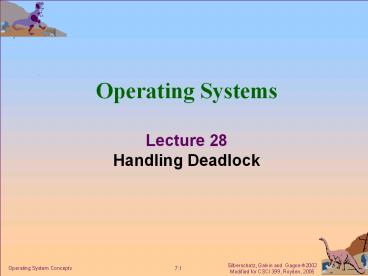Module 7: Process Synchronization - PowerPoint PPT Presentation
Title:
Module 7: Process Synchronization
Description:
Operating Systems Lecture 28 Handling Deadlock Resource-Allocation Graph V is partitioned into two types: P = {P1, P2, , Pn}, the set consisting of all the ... – PowerPoint PPT presentation
Number of Views:46
Avg rating:3.0/5.0
Title: Module 7: Process Synchronization
1
Operating SystemsLecture 28 Handling Deadlock
2
Resource-Allocation Graph
A set of vertices V and a set of edges E.
- V is partitioned into two types
- P P1, P2, , Pn, the set consisting of all
the processes in the system. - R R1, R2, , Rm, the set consisting of all
resource types in the system. - request edge directed edge Pi ? Rj
- assignment edge directed edge Rj ? Pi
3
Resource-Allocation Graph (Cont.)
- Process
- Resource Type with 4 instances
- Pi requests instance of Rj
- Pi is holding an instance of Rj
Pi
Rj
Pi
Rj
4
Example of a Resource Allocation Graph
5
Resource Allocation Graph With A Deadlock
6
Resource Allocation Graph With A Cycle But No
Deadlock
7
Basic Facts
- If graph contains no cycles ? no deadlock.
- If graph contains a cycle ?
- if only one instance per resource type, then
deadlock. - if several instances per resource type,
possibility of deadlock.
8
Methods for Handling Deadlocks
- Ensure that the system will never enter a
deadlock state. - Allow the system to enter a deadlock state and
then recover. - Ignore the problem and pretend that deadlocks
never occur in the system used by most operating
systems, including UNIX.
9
Deadlock Prevention
Make sure at least one of the four conditions for
deadlock cannot hold
- Mutual Exclusion not required for sharable
resources must hold for nonsharable resources. - Hold and Wait must guarantee that whenever a
process requests a resource, it does not hold any
other resources. - Require process to request and be allocated all
its resources before it begins execution, or
allow process to request resources only when the
process has none. - Disadvantages Low resource utilization
starvation possible.
10
Deadlock Prevention (Cont.)
- No Preemption
- If a process that is holding some resources
requests another resource that cannot be
immediately allocated to it, then all resources
currently being held are released. - Preempted resources are added to the list of
resources for which the process is waiting. - Process will be restarted only when it can regain
its old resources, as well as the new ones that
it is requesting. - doesn't work well with printer resources. Works
well for memory resources. - Circular Wait impose a total ordering of all
resource types, and require that each process
requests resources in an increasing order of
enumeration.
11
Deadlock Avoidance
Requires that the system has some additional a
priori information available.
- Simplest and most useful model requires that each
process declare the maximum number of resources
of each type that it may need. - The deadlock-avoidance algorithm dynamically
examines the resource-allocation state to ensure
that there can never be a circular-wait
condition. - Resource-allocation state is defined by the
number of available and allocated resources, and
the maximum demands of the processes.
12
Safe State
- A state is safe if the system can allocate
processes to each process (up to its maximum) in
some order and avoid deadlock. - When a process requests an available resource,
system must decide if immediate allocation leaves
the system in a safe state. - System is in safe state if there exists a safe
sequence of all processes. - Sequence ltP1, P2, , Pngt is safe if for each Pi,
the resources that Pi can still request can be
satisfied by currently available resources
resources held by all the Pj, with jlti. - If Pi resource needs are not immediately
available, then Pi can wait until all Pj have
finished. - When Pj is finished, Pi can obtain needed
resources, execute, return allocated resources,
and terminate. - When Pi terminates, Pi1 can obtain its needed
resources, and so on.
13
Basic Facts
- If a system is in safe state ? no deadlocks.
- If a system is in unsafe state ? possibility of
deadlock. - Avoidance ? ensure that a system will never enter
an unsafe state.
14
Safe, Unsafe , Deadlock State
15
Example
Suppose a system has 12 tape drives and 3
processes. At time t0, the system is as
follows Process Max need Current
need P0 10 5 P1 4 2 P2 9 2 3 tape
drives are unallocated. Is the system
safe? Suppose process P2 is allocated another
tape drive at time t1. Is the system safe?
16
Resource-Allocation Graph Algorithm
- Works for systems with only 1 instance of each
resource type. - Create a resource allocation graph that uses
claim edges. - A Claim edge Pi ? Rj indicated that process Pj
may request resource Rj represented by a dashed
line. - Claim edge converts to request edge when a
process requests a resource. - When a resource is released by a process,
assignment edge reconverts to a claim edge. - Resources must be claimed a priori in the system.
- If there are no cycles in the graph, the system
is in a safe state. - Must use a cycle detection algorithm to test for
a safe state.
17
Resource-Allocation Graph For Deadlock Avoidance
18
Unsafe State In Resource-Allocation Graph































